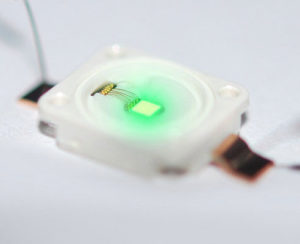With the help of DOE funding , researchers at the University of California at Santa Barbara are conducting analyses to determine the mechanisms underlying efficiency loss in light-emitting diodes (LEDs) used in solid-state lighting. The researchers’ efforts focus on understanding the cause of the relatively low efficiency of green LEDs, which is commonly referred to as the “green gap,” as well as of the high-temperature efficiency losses known as “thermal droop.”
, researchers at the University of California at Santa Barbara are conducting analyses to determine the mechanisms underlying efficiency loss in light-emitting diodes (LEDs) used in solid-state lighting. The researchers’ efforts focus on understanding the cause of the relatively low efficiency of green LEDs, which is commonly referred to as the “green gap,” as well as of the high-temperature efficiency losses known as “thermal droop.”
As an electron passes through an LED, it can go through several recombination processes, only one of which produces light (radiative recombination). When an electron recombines via any of the other mechanisms (non-radiative recombination), it results in efficiency loss. Depending on which of these loss mechanisms is occurring, the electrons transiting the LED will have a different energy distribution. For example, efficiency loss in blue LEDs is primarily due to Auger recombination, which excites an electron to a high energy state instead using this energy to emit a photon.
The UCSB researchers are using an ultra-high vacuum (UHV) chamber designed to directly analyze the electron energy spectrum emitted from LEDs. Their analysis has already shown that for green LEDs, a surprisingly large number of electrons escape from carrier confinement regions without producing light. This process is known as “carrier leakage” or “overshoot,” and occurs in addition to Auger recombination, causing green LEDs to have much lower efficiency than blue LEDs, which are the engine for state-of-the-art solid-state lighting.
When operated at elevated temperatures, blue LEDs also show an increase in electrons lost via carrier leakage and/or overshoot. This increase of leakage/overshoot coincides with the onset of the decrease of light output at ~75 °C, a temperature range at which LEDs are commonly operated. These results are consistent with the expected onset of the thermal droop that’s been widely reported in scientific literature.
These measurements are a vital component for advancing our understanding of LED efficiency-loss mechanisms. With this knowledge, it’s possible to engineer solutions to mitigate these problems and push the limits of energy-efficient lighting even higher. Development of new confinement region structures to minimize the number of electrons lost to leakage/overshoot will be an integral part of achieving the efficiency goals set out by DOE.
The Department of Energy has provided nearly $1,000,000 to fund this research project.
Tagged with Department of Energy, lightED